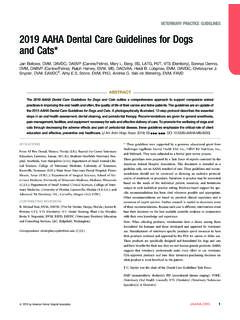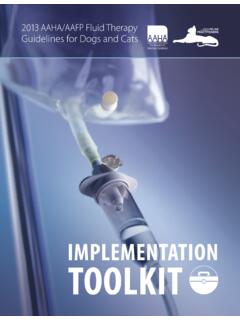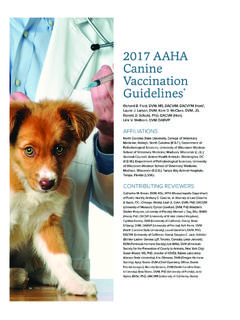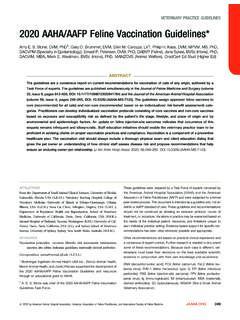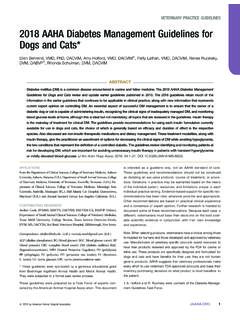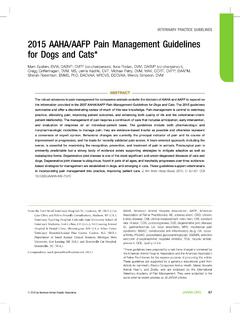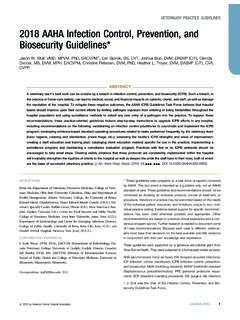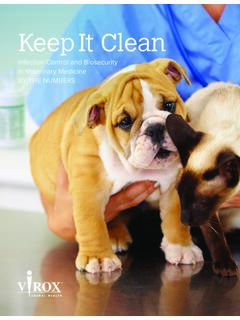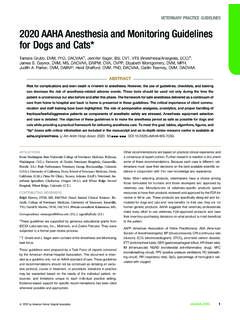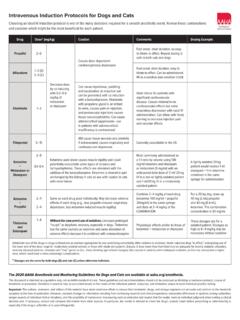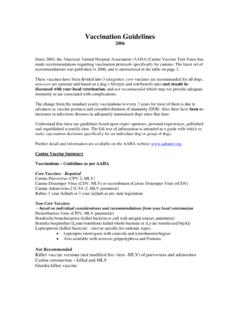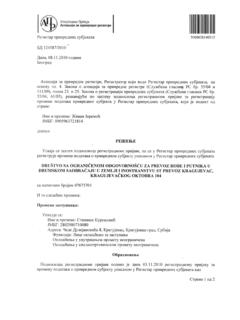Transcription of 2017 AAHA Canine Vaccination Guidelines
1 26 TRENDS MAGAZINE2017 aaha Canine Vaccination Guidelines *Richard B. Ford, DVM, MS, DACVIM, DACVPM (Hon) , Laurie J. Larson, DVM, Kent D. McClure, DVM, JD, Ronald D. Schultz, PhD, DACVM (Hon), Link V. Welborn, DVM, DABVP AFFILIATIONSN orth Carolina State University, College of Veterinary Medicine, Raleigh, North Carolina ( ); Department of Pathobiological Sciences, University of Wisconsin-Madison School of Veterinary Medicine, Madison, Wisconsin ( ); General Counsel, animal Health Institute, Washington, DC ( ); Department of Pathobiological Sciences, University of Wisconsin-Madison School of Veterinary Medicine, Madison, Wisconsin ( ); Tampa Bay animal Hospitals, Tampa, Florida ( ).
2 CONTRIBUTING REVIEWERSC atherine M. Brown, DVM, MSc, MPH (Massachusetts Department of Public Health); Anthony E. Cascino, Jr. Attorney at Law (Cascino & Assoc, ; Chicago, Illinois); Leah A. Cohn, DVM, PhD, DACVIM (University of Missouri); Cynda Crawford, DVM, PhD (Maddie s Shelter Program, University of Florida); Michael J. Day, BSc, BVMS (Hons), PhD, DECVP (University of Bristol, United Kingdom); Cynthia Delany, DVM (University of California, Davis); Brian DiGangi, DVM, DABVP (University of Florida); Kelli Ferris, DVM (North Carolina State University); Laurel Gershwin, DVM, PhD, DACVM (University of California, Davis); Douglas C.
3 Jack, Solicitor (Borden Ladner Gervais LLP, Toronto, Canada); Linda Janowitz, DVM (Peninsula Humane Society); Lila Miller, DVM ( american Society for the Prevention of Cruelty to Animals, New York City); Susan Moore, MS, PhD, director of KSVDL Rabies Laboratory (Kansas State University); Kris Otteman, DVM (Oregon Humane Society); Apryl Steele, DVM (Chief Operating Officer, Dumb Friends League); Brenda Stevens, DVM (North Carolina State University); Amy Stone, DVM, PhD (University of Florida); Jane Sykes, BVSc, PhD, DACVIM (University of California, Davis).
4 269/12/17 10:46 AMOCTOBER 2017 27 Executive SummaryTHE american animal hospital association ( aaha ) is pleased to introduce this revision of the Canine Vaccination Guidelines published, for the first time, as an online educational resource for the veterinary medical profession. This format will allow for frequent online updates as necessary. The revised aaha Canine Vaccination Guidelines offer important updates to the 2011 Guidelines . The content of the Guidelines has been significantly expanded to facilitate efforts by practicing veterinarians to meet patient and client needs in a complex infectious disease environment.
5 The Guidelines are an authoritative source of evidence-based recommendations and expert opinion provided by the aaha Canine Vaccination Guidelines Task Force. The Task Force includes individuals with extensive experience in primary care practice, academia, shelter medicine, public health, and veterinary law related to clinical there is often consensus on which Canine vaccines fall into core and noncore categories and when they should be administered, in practice, the Vaccination protocol should always be individualized based on the patient s risk factors, life stage, and lifestyle.
6 For this reason, these Guidelines are not intended to represent a universal Vaccination protocol applicable to all dogs. Instead, the Guidelines offer a range of recommendations that will aid practitioners in making rational decisions on vaccine selection for their individual aaha Canine Vaccination Guidelines offer important updates to previously published Guidelines as well as new, relevant information that directly impacts the practicing veterinarian: Updated, quick-reference tables summarizing Vaccination recommendations for client-owned and shelter-housed dogs.
7 Internet links that provide ready access to regularly updated online sources of information that will supplement the Guidelines themselves, for example, state-by-state information on rabies Vaccination law and regulations, and comprehensive information on vaccine storage and handling. Algorithms outlining indications for antibody testing (serology) as well as recommended actions for patients with a positive or negative test result. Product information on the emerging class of immunotherapeutics approved for use in veterinary one of the safest and most cost-effective means of infectious disease prevention, Vaccination has long been a focal point of Canine practice.
8 This revision of the entire aaha Canine Vaccination Guidelines is presented in an online format at Termed an Online Educational Resource, this iteration of the aaha Canine Vaccination Guidelines offers readers immediate accessibility to current, must-know information that directly impacts clinical practice on a daily table on Vaccination recommendations in practice is an up-to-date, master reference that functions as a stand-alone resource covering all commercially available Canine vaccines licensed in the United States and Canada.
9 Core and noncore vaccines are listed along * These Guidelines were prepared by a task force of experts convened by the american animal hospital association . This document is intended as a guideline only, not an aaha standard of care. These Guidelines and recommendations should not be construed as dictating an exclusive protocol, course of treatment, or procedure. Variations in practice may be warranted based on the needs of the individual patient, resources, and limitations unique to each individual practice setting.
10 Evidence-based support for specific recommendations has been cited whenever possible and appropriate. Other recommendations are based on practical clinical experience and a consensus of expert opinion. Further research is needed to document some of these recommendations. Because each case is different, veterinarians must base their decisions on the best available scientific evidence in conjunction with their own knowledge and Guidelines were sponsored by a generous educational grant from Boehringer Ingelheim, Merial, Merck animal Health, and Zoetis.
